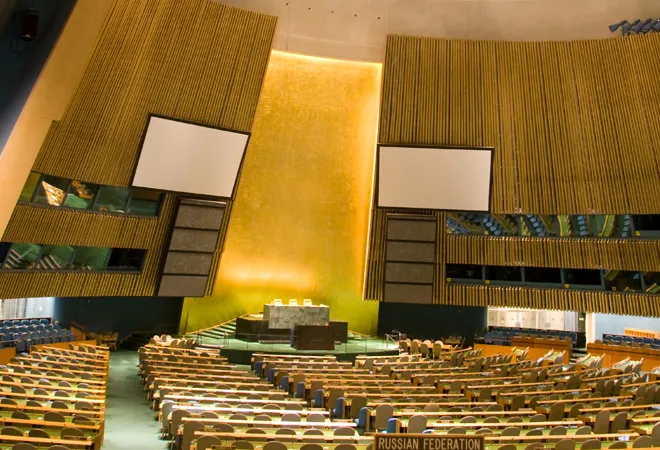
This piece is part of the series, India@75: Aspirations, Ambitions, and Approaches
The post-World War II multilateral order may have been shaped largely by the western allies, but this did not deter India from taking on an active role across different negotiations for the setting up of new international organisations. For instance, even before the country won independence in 1947, its negotiators worked systematically to ensure that any international trade organisation that emerged would take into account its interests (and the concerns of several other developing countries). India was a founding member of the United Nations (UN), and an original signatory to the General Agreement on Tariffs and Trade (GATT). Even when the rules of the game did not turn out to its advantage—it was neither a permanent member of the UN Security Council, nor was it a member of the informal decision-making “Quad” group in the GATT—its enthusiasm for multilateralism seldom waned.
Over the next 70 years, sometimes in coalitions and sometimes alone, the world’s largest democracy sought to reform the multilateral system from the inside. This earned it a reputation of being a “difficult” negotiator, especially when dealing with western counterparts. Its persistent activism, however, contributed to at least some updating of the system (e.g., the World Trade Organisation, from the mid-2000s onwards,
began to include Brazil and India in the Quad). And the multilateral system, in turn, served India well: India’s dramatic rise since the turn of the millennium, while in good measure a function of its domestic economic and social reforms, has also been facilitated by the many growth and development opportunities afforded to it by free markets and the absence of major wars.
India was a founding member of the United Nations (UN), and an original signatory to the General Agreement on Tariffs and Trade (GATT).
Today, multilateralism faces a crisis of unprecedented proportions.
The crisis has several sources. It manifests itself in a fundamental questioning of the very value of multilateralism within countries and deadlocks in negotiations in multilateral organisations. Add to this the phenomenon of “
Weaponised Interdependence” – the ability of some powerful states to exploit the control that they exercise over hubs of production networks in a world of closely integrated global value chains – and it is clear that
multilateral institutions are ill-suited to meet the challenges of the present day. The long-standing vulnerabilities of the multilateral system have been laid bare by the pandemic: The
World Health Organisation has come under much critique for its mishandling of COVID-19; even now the World Trade Organisation stands by helplessly as members continue to bicker over the TRIPS waiver, and potential capacity for vaccine and medicine production in the Global South cannot be put to its much-needed use.
The system is in dire crisis, at a time when the world needs it most; collapse of the system would hurt all parties, including India. Yet, amidst all the handwringing, it is often forgotten that the crisis of multilateralism could offer new opportunities that India should harness.
Never let a good crisis go to waste
The opportunities emerging directly from the crisis are fourfold. First, while India itself had, for decades, pushed for reforms in the multilateral order (e.g., for greater inclusiveness in international organisations), the crisis of the system seems to have finally created a more widespread recognition for the necessity of reform. Second, key players in the west—especially in Europe—have begun to recognise that they need new allies and friends. This is especially so given that the US seems to be turning away from the very system that it had led in creating, and then served as a guarantor for. Third, a significant cause for the malaise of multilateralism lies in the disillusionment of the many—within both the global north and the global south—who believe that they have missed out on the gains of globalisation. This disillusionment, in turn, is a product not only of inequalities that have indeed increased across many societies, but also of the absence of a convincing narrative about globalisation and the multilateral rules that facilitate it. In some key policy circles in developed countries, this has prompted considerable soul-searching, as exemplified by Munich Security Conference 2020 and its focus on “westlessness”. And fourth, a recognition seems to be finally growing that sometimes helter-skelter globalisation—in a world where production chains can be weaponised—is no longer acceptable. Alternative and more sustainable forms of globalisation need to be developed, which meet goals of both prosperity and security. The moment is ripe for sharing new ideas. And while
India has always had much to offer the world, the world may now be ready to appreciate it.
A significant cause for the malaise of multilateralism lies in the disillusionment of the many—within both the global north and the global south—who believe that they have missed out on the gains of globalisation.
Strategies
To make the most of these opportunities, India would be well-served to adopt the following strategies.
First, India, even it was to come up with the most innovative ideas for reform of the system, will not be effective if it works alone. Coalitions with like-minded actors will be key. Here, India could work closely with the Alliance for Multilateralism—an initiative launched by Germany and France—to shape both the alliance itself and the overall reform agenda. Working together with a group of both developed and developing countries could further amplify India’s voice.
Second, while keeping an eye on the global picture, India needs to pay attention to its own immediate region. Connecting the regional with the global is China’s Belt and Road Initiative (BRI). India risks finding itself in a precarious geo-economic position, surrounded by the so-called “string of pearls” and potentially weak in a world where interdependence can be weaponised. Especially with key actors—such as the United States, European Union, and Japan—diversifying away from China, India too has a potential route to escape an emerging Chinese sphere of influence. By hedging and balancing, and working in coalitions with other countries also facing such dilemmas—including in Europe—
India could carve out an important niche for itself as a shaper of the multilateralism that upholds the liberal order.
India risks finding itself in a precarious geo-economic position, surrounded by the so-called “string of pearls” and potentially weak in a world where interdependence can be weaponised.
Third, while India today seems to be laying emphasis on pragmatism rather than ideology, it would do well to tap into some of the core values that it stands for: Democracy, pluralism, rule of law, and freedom of speech. Values matter because multilateralism is little more than an instrument
per se; it cannot be seen as a goal in itself. Rather, one must ask: Multilateralism, for what end? To argue for a multilateral rules-based system will never suffice on its own; one must always address the issue of the values that underpin the rules. This attention to values could turn out to be especially important in the context of China’s rise.
Finally, none of the above strategies will work if India fails to get its act together domestically. Here, the most important sector is the economy. Its own people will not support its growing role internationally, if the government fails to deliver with jobs and better living standards. The pandemic is a very tough test for governments everywhere. There is a danger that as a reaction to the pandemic—and the costs of over-dependence on potential rivals that it revealed—India swings in the opposite direction with its Atmanirbhar Bharat Abhiyan (literally “self-reliant India campaign”). If “self-reliance” turns out to be similar to “self-sufficiency” of earlier decades, India risks undoing its hard-won gains of the last 30 years. Choosing the right economic strategies will be even more important amidst the global economic downturn that the coronavirus pandemic is already causing. These strategies will need to strike the right balance between shortening supply chains on the one hand (which the current drive aims for), while still preserving and deepening economic integration with reliable allies. Between aggressive globalisation and market closure, India will have to find its “Suvarna madhyam” (golden mean) that will be based on strategic economic diversification within a small group of like-minded countries. Internationally, too, an India rising on sustainable economic growth—in cooperation with others who share its values of democracy, pluralism, liberalism and more—will have more bargaining clout and persuasive power than an inward-looking India caught up in domestic political upheavals and slowing growth rates. After all, a strengthened and reformed multilateralism will need to have strong roots in the domestic politics of the countries that seek to uphold it.
The views expressed above belong to the author(s). ORF research and analyses now available on Telegram! Click here to access our curated content — blogs, longforms and interviews.




 PREV
PREV


